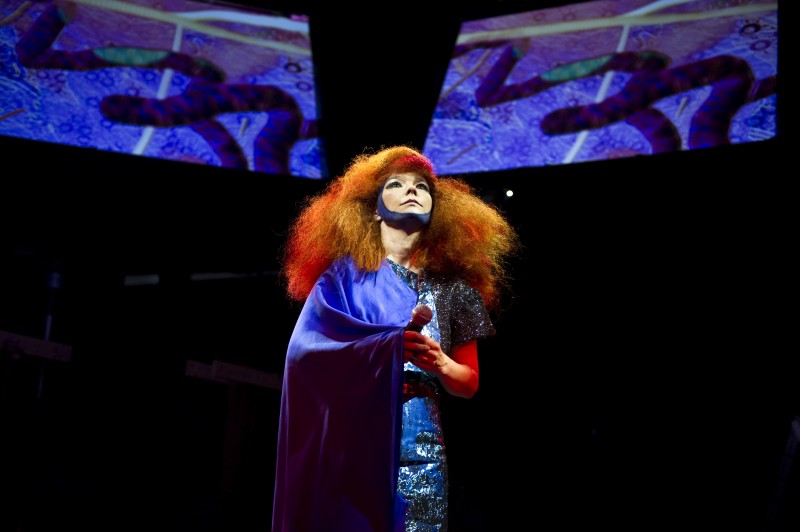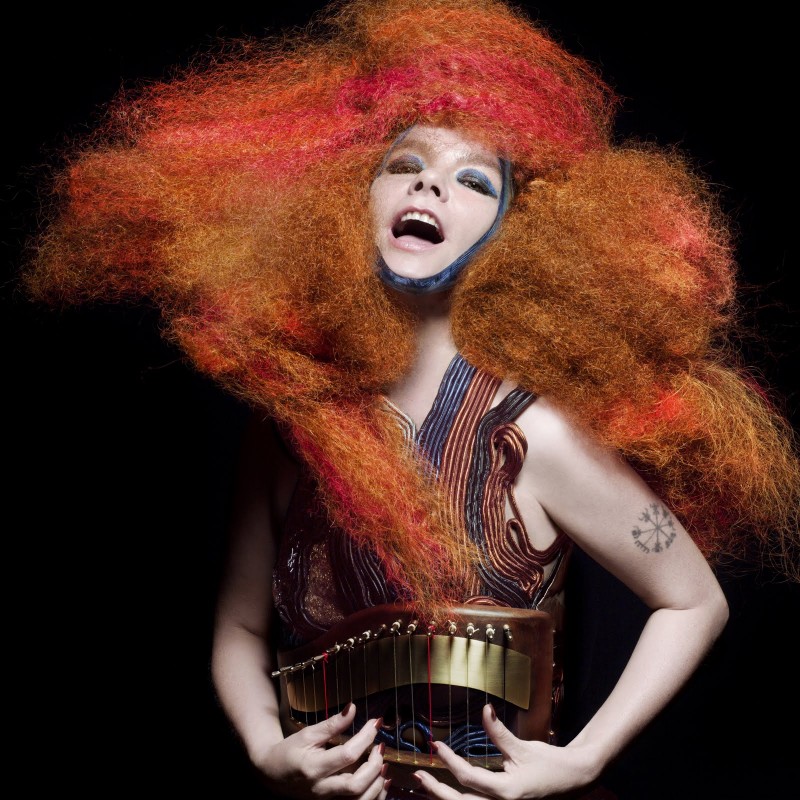Welcome to Biophilia
The deep, soothing sound of David Attenborough’s voice greets the audience at the specially adapted Campfield Market Hall for Björk’s final Biophilia performance at the Manchester International Festival. The excitement in the crowd is palpable; all can sense the spectacle about to unfurl.
Feature by Sam Holder
The biennial Manchester International Festival prides itself on providing a platform for artists to present original performances – “new works from across the spectrum of performing arts, visual arts and popular culture”. Biophilia, the highly anticipated jewel in the crown of this year’s festival, certainly embraces the ethos. Attenborough fittingly enlightens the audience that Biophilia is “the love for nature in all of her manifestations. With Biophilia comes a restless curiosity – an urge to investigate and discover the elusive places where we meet nature”.
For the show is more than just a preview of Björk’s new album. According to the explanatory booklet handed out upon entering the market, this is to be an educational experience. Tonight’s performance is just one facet of a multitude of components that make up the Biophilia project (the others being “two versions of the same album, specially commissioned apps, newly invented musical instruments, internet presence, a documentary and an educational workshop”), which endeavours to explore the relationship between music, nature and technology. And much like the subject matter it is dealing with, the Biophilia project is ever evolving.
While the concept may sound somewhat bewildering, through the use of multimedia (in particular eight elevated screens circling the stage) and Attenborough’s reasoned introductions to most of the songs, it appeared that the majority of the audience managed to at least somewhat grasp the principal ideas behind Björk’s ambitious project. Whether or not the biophilosophical nature of the show struck a chord with the audience; the show itself is a masterpiece. Björk, face shrouded by a giant orange afro, enters the fray flanked by 26 angelic Icelandic chorists, bedecked in flowing metallic dresses evocative of an ultra-futuristic druidic sect. The stage itself is circular, which Björk exploits throughout the show to its greatest possibility, performing to different sections of the crowd at different points. While performing in the round has often been viewed with contempt by concert-goers (due to the fact that you will invariably witness at least one song performed by the back, shoulders and hair of the artist), the Biophilia stage is full of such wonderment that one hardly notices.
Original instruments created for the project encircle the stage. Firstly a midi converted pipe organ remotely controlled by a computer plays adapted versions of songs from Björk’s back-catalogue before any of her entourage even appears onstage. A hybrid of a 19th century European celeste filled with the bronze bars of an Indonesian gamelan creates the delightful chimes of the Gameleste. On the other side of the stage stand four imposing pendulum harps that “harness the earth’s gravitational pull to create musical patterns”. And who could forget the bizarre giant baroque-style sharpsicord – a colossal pin-barrel harp. It felt like Willy Wonka had suffered a mid-life crisis and decided to foray into the world of music.
A giant steel cage descending from the heavens introduces the first song. The cage, it transpires, contains two tesla coils, and the raw resonant sound of the visual sparks of electricity striking the cage forms the basis for the aptly named Thunderbolt. Björk expertly juxtaposes the brutal bass of the tesla coils with a delicate lyrical and vocal performance, which keeps the audience fully captivated. Songs from the forthcoming album are plentiful and sound, as ever with Björk, as if they transcend earthly parameters. Leading single ‘Crystalline’ with its twinkling electronic manipulation of the Gameleste subtly takes the listener down an ethereal lullaby-esque path before suddenly exploding into an organised chaos of heady drum and bass. Each new track is accompanied by a specially created video to elaborate the concept behind the song. The mesmerising video for ‘Moon’ shows each stage of the moon’s monthly cycle pulsating with the beat of the song, while the video for ‘Crystalline’ has the feel of the retro video game ‘copter’ with each tunnel representing a section of the music and the crystals representing beats. Björk’s magical reinvention of a virus as a metaphor for love and obsession is made complete by a delicate animation of a pathogen attacking a human cell on ‘Virus’.

But new and delicate is not the only order of the day. During the classic ‘Hidden Place’, clips from the Attenborough-narrated ‘Life’ series are offered and focus on a variety of eel-like creatures entering their ‘hidden place’, in this instance boring into the eye of a lifeless seal pup. A truly exceptional version of ‘Mouth’s Cradle’ ignores visual gadgetry but employs the choir to the peak of their ability, turning an oft-overlooked track into a striking highlight.
However with its explicit aim of education and plethora of technological innovations, it does at times feel like Biophilia is a musical lecture, albeit the most enjoyable and breathtaking lecture one could hope to witness. Perhaps a more fair term would be a ‘spectacle’ because despite being a triumphant performance, audience participation was non-existent. No singing along, certainly no dancing, and during the opening section of the set, the audience appeared too shy to even cheer after each song – a round of applause was deemed most acceptable. Considering the fact that Biophilia is an interactive project, hence the development of apps for each song on the album, surely this teacher-like reverence towards Miss. Guðmundsdóttir wasn’t her desired response. For even when she implored the crowd to “act like hooligans” during her specifically reworked encore consisting of classic stormers ‘Hyperballad’ and ‘Pluto’ (which was altered to sound like a rave in the depths of the ocean), the mass of people didn’t really know what to do with themselves.
Omar Souleyman Remix Crystalline
Yet Björk is a natural performer of the highest calibre, for even without the bells and whistles and ‘sharpsicords’, she has the ability to completely mesmerise her audience. An incredibly poignant rendition of ‘One Day’ from her ‘Debut’ album is the stand-out moment of the show. Stripped down and simply accompanied by Manu Delago on the gloriously warm and rich-sounding Hang drum (an instrument shaped like a flying saucer most closely related to a steel drum), ‘One Day’ showcases Björk’s unmatched vocal talent and has the audience utterly spellbound, allowing them to drift amongst the clouds in her ethereal kingdom, with no high-tech distractions.
